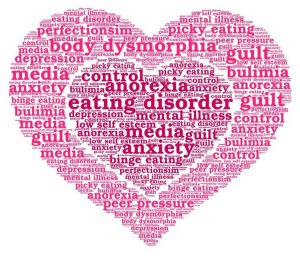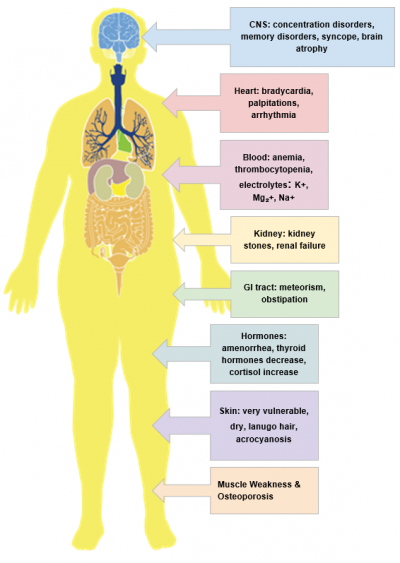Nancy’s Health: Eating Disorders
Nancy’s Story Continues…
- Nancy met with her multidisciplinary healthcare team as scheduled
- Her mother watched her closely, recording her food intake, physical activity, sleep patterns, and her menstrual cycles
- Her father did not see what all the fuss was about… ”go back to doing what you love”
- She went to her appointments to appease her mother and family doctor
- She continued to binge & purge
- She often skipped classes to go running
- It took 3 years of hard work for her to get to a healthy weight, have a realistic view on exercise, & to having monthly menstrual periods
Overview
Eating disorders are persistent eating behaviours that negatively impact your health, emotions, & your ability to function.
- Focuses on weight, body shape & food, leading to dangerous eating behaviours.
- Eating disorders can harm the heart, digestive system, bones, teeth & mouth, & lead to other diseases.
Most common eating disorders are:
- Anorexia nervosa
- Bulimia nervosa
- Binge-eating disorder
Symptoms
Anorexia Nervosa
- Dramatic weight loss
- Dresses in layers to hide weight loss or stay warm
- Preoccupation with weight, food, calories, fat grams, and dieting. Makes frequent comments about feeling “fat”
- Resists or is unable to maintain a body weight appropriate for their age, height, and build
- Maintains an excessive, rigid exercise regime – despite weather, fatigue, illness, or injury
Bulimia Nervosa
- Evidence of binge eating, including disappearance of large amounts of food in short periods of time or lots of empty wrappers and containers indicating consumption of large amounts of food
- Evidence of purging behaviors, including frequent trips to the bathroom after meals, signs and/or smells of vomiting, presence of wrappers or packages of laxatives or diuretics
- Drinks excessive amounts of water or non-caloric beverages, and/or uses excessive amounts of mouthwash, mints, and gum
- Has calluses on the back of the hands and knuckles from self- induced vomiting
- Dental problems, such as enamel erosion, cavities, discoloration of teeth from vomiting, and tooth sensitivity
Binge Eating Disorder
- Secret recurring episodes of binge eating (eating in a discrete period of time an amount of food that is much larger than most individuals would eat under similar circumstances); feels lack of control over ability to stop eating
- Feelings of disgust, depression, or guilt after overeating, and/or feelings of low self-esteem
- Steals or hoards food in strange places
- Creates lifestyle schedules or rituals to make time for binge sessions
- Evidence of binge eating, including the disappearance of large amounts of food in a short time period or a lot of empty wrappers and containers indicating consumption of large amounts of food
Causes
Genetics & biology
Certain people may have genes that increase their risk of developing eating disorders. Biological factors, such as changes in brain chemicals, may play a role in eating disorders.
Psychological & emotional health
People with eating disorders may have psychological and emotional problems that contribute to the disorder. They may have low self-esteem, perfectionism, impulsive behavior and troubled relationships.
Risk Factors
Family history
Eating disorders are significantly more likely to occur in people who have parents or siblings who’ve had an eating disorder.
Other mental health disorders
People with an eating disorder often have a history of an anxiety disorder, depression or obsessive-compulsive disorder.
Dieting & starvation
Dieting is a risk factor for developing an eating disorder. Starvation affects the brain and influences mood changes, rigidity in thinking, anxiety and reduction in appetite. There is strong evidence that many of the symptoms of an eating disorder are actually symptoms of starvation. Starvation and weight loss may change the way the brain works in vulnerable individuals, which may perpetuate restrictive eating behaviors and make it difficult to return to normal eating habits.
Stress
Whether it’s heading off to college, moving, landing a new job, or a family or relationship issue, change can bring stress, which may increase your risk of an eating disorder.
Complications
- Serious health problems
- Depression & anxiety
- Suicidal thoughts or behaviour
- Problems with growth & development
- Social & relationship problems
- Substance use disorders
- Work & school issues
- Death



